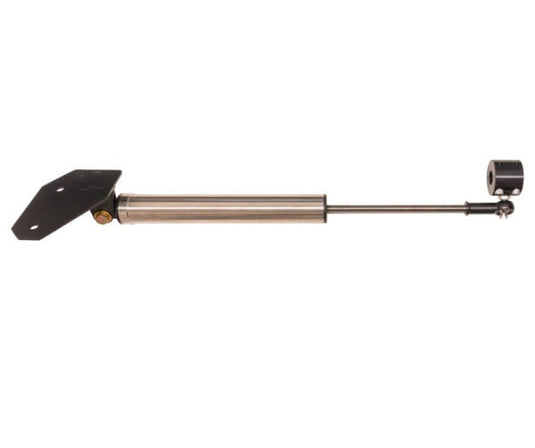SKU: CS-DHMSS-14
- Direct bolt-in
- Corrects right tire pull, adjustable
- Fits Leveled & Lifted trucks, ONLY.
- Does NOT Fit with Factory Power Wagon Sway Bar.
- Fitment: 2014-18 Ram 2500, 4×4
- Fitment: 2013-18 Ram 3500, 4×4
Contrary to popular belief, It’s not a magic cure for a wandering truck and it won’t fix your death-wobble. Well, it may mask Death Wobble and certainly helps ward it off by damping front-end forces leading to it but, I digress – read our other blog article if you’re after a fix for death wobble… A steering Stabilizer is simply a damper designed for your steering. A Steering Damper’s purpose is to increase steering predictability while minimizing volatility, road noise and driver fatigue. Simply put, a good steering stabilizer will stabilize the steering; shocker, right?
Stock Steering Stabilizers are designed for stock steering and stock tires. They work well in this application (for about 50,000 miles) and ONLY this application. Throw on a Carli kit and some 35” or 37” tires and you’ll be left wanting. When the tire size increases, the stabilizer should be upgraded as well. Larger, aftermarket tires are significantly heavier and harder to control than factory tires, even in on-road applications.
SKU: CS-DHMSS-14
- Direct bolt-in
- Corrects right tire pull, adjustable
- Fits Leveled & Lifted trucks, ONLY.
- Does NOT Fit with Factory Power Wagon Sway Bar.
- Fitment: 2014-18 Ram 2500, 4×4
- Fitment: 2013-18 Ram 3500, 4×4
Contrary to popular belief, It’s not a magic cure for a wandering truck and it won’t fix your death-wobble. Well, it may mask Death Wobble and certainly helps ward it off by damping front-end forces leading to it but, I digress – read our other blog article if you’re after a fix for death wobble… A steering Stabilizer is simply a damper designed for your steering. A Steering Damper’s purpose is to increase steering predictability while minimizing volatility, road noise and driver fatigue. Simply put, a good steering stabilizer will stabilize the steering; shocker, right?
Stock Steering Stabilizers are designed for stock steering and stock tires. They work well in this application (for about 50,000 miles) and ONLY this application. Throw on a Carli kit and some 35” or 37” tires and you’ll be left wanting. When the tire size increases, the stabilizer should be upgraded as well. Larger, aftermarket tires are significantly heavier and harder to control than factory tires, even in on-road applications.

